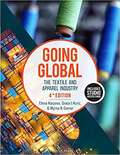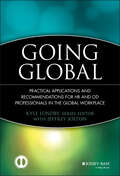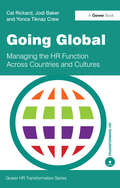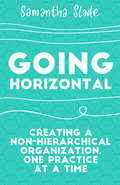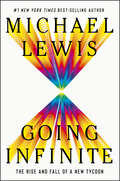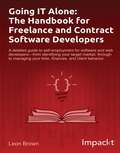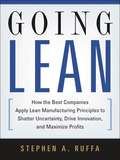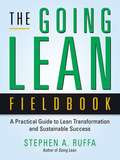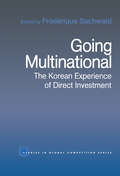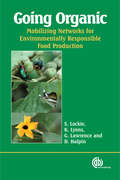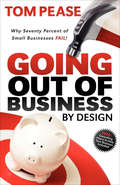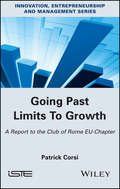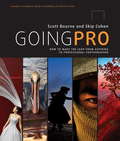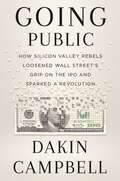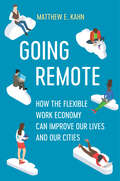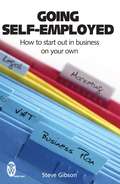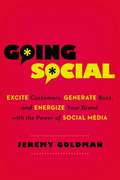- Table View
- List View
Going Global: The Textile and Apparel Industry
by Elena E. Karpova Grace I. Kunz Myrna B. GarnerThe manufacturing and distribution of textiles and apparel products is a truly global industry, making it crucial to understand current political, social and economic developments within the international marketplace. <p><p> Going Global offers a comprehensive framework and approach to understanding the global textile and apparel industries, trade and markets. This framework is used to holistically examine the global sourcing of textiles and apparel in the context of the supply chain sustainability, while exploring the roles and specializations of world regions and selected countries that are major players in the textile and apparel marketplace.
Going Global
by Allen I. Kraut Kyle Lundby Jeffrey JoltonThis book uses the employee lifecycle as an underlying organizing framework and examines critical phases in I/O practice and the employee lifecycle (e.g., selection/placement, performance management/development, ongoing organizational performance). It also shows how they are manifested in a global and culture-spanning space. The book showcases various sets of I/O practices that are firmly grounded in good science. Throughout the book, practical advice is offered by those who have engaged clients globally in each of these phases. This resource is written for global I/O faculty and practitioners, students, and HR professionals.
Going Global: Managing the HR Function Across Countries and Cultures (Gower HR Transformation Series)
by Cat Rickard Jodi BakerAs organizations operate across countries and continents there is an increasing demand for the development of an HR function designed to deliver global support. This requires rethinking the structure of HR, how it is managed and how it operates. However, adopting a fully global model is not the right answer for all organizations. HR has a key role in determining the business strategy in terms of the required scale of operations (i.e. local/regional/global), and in delivering the business transformation required to realize that strategy once it has been agreed. As a result, HR must be both able and prepared to transform itself to support the new business model. Going Global outlines of the types of activity and capability needed to establish an HR function able to supporting business operations at a regional or global level. It focuses on two areas, the decision to go global and the activities needed to deliver a global HR function. This latter section targets three areas: designing the right service; building a cohesive team; and delivering HR talent. The authors point out some of the key decisions you will need to take, together with advice on your overall approach, and some of the lessons learned by other organizations along the way. About The Gower HR Transformation Series: The Human Resources function faces a continuing challenge to its role and purpose, in many organizations it has suffered from serious under-representation at strategic, board level. Yet, faced with the challenges of globalism, the need to innovate, manage knowledge, attract and retain the very best employees, organizations need an HR function that can lead from the front. The process of transforming the function is complex and rarely linear. It involves understanding and adapting to the needs of your offices in the various countries, cultures and markets within which you operate. All of which involves a highly complex and, often painful, process of change. The Gower HR Transformation Series will help; it uses a blend of conceptual frameworks, practical advice and global case study examples to cover each of the main elements of the HR transformation process. The books in the series follow a standard format to make them easy to read and reference. Together, the titles create a definitive guide from one of the leading specialist HR transformation consultancies; an organization that has been involved in HR transformation for clients as diverse as Bombardier Transportation, Marks & Spencer, Barnardo's, Oxfam, Schroders, UnitedHealth Group, Nestlé, BP, HM Prison Service, Transport for London and Vodafone.
Going Horizontal: Creating a Non-Hierarchical Organization, One Practice at a Time
by Samantha SladeHierarchy in organizations is obsolete. There is a better way: one that increases the engagement of employees and managers alike, reduces micromanaging and other limiting approaches, and promotes organizational and individual success. In this book, self-management expert Samantha Slade presents seven concrete practices to help your organization flatten its existing hierarchy and develop a horizontal organization. The result will be enhanced creativity, greater growth, and a increased employee retention and productivity—and a better bottom line.These days, more than ever, successful organizations must respond quickly and nimbly to change—they need every employee's best thinking. A horizontal organization creates an environment of true collaboration, respect, and openness. It allows everyone more freedom to express unconventional ideas or to work through issues that are getting in the way of organizational goals. And it's a more human way to organize—after all, we function perfectly well in our day-to day lives without someone telling us what to do. But when an organization decides to go horizontal, it can be overwhelming for both managers and employees. Slade offers a practical, proven, incremental method to help organizations of all kinds and sizes ease in to a non-hierarchical model. She includes techniques for using your organization's purpose to stay focused and aligned, developing shared decision-making, creating a mutual feedback culture, nurturing autonomy, holding co-managed meetings, and maintaining an environment of collective learning. Going Horizontal will help organizations become more adaptive, collaborative and innovative, which is vital in today's highly competitive and constantly-evolving world.
Going Infinite: The Rise And Fall Of A New Tycoon
by Michael LewisAN INSTANT #1 NEW YORK TIMES BESTSELLER One of the New Yorker's Best Books of 2023 • One of Pure Wow's 42 Book to Gift This Year • One of Fortune's Best Crypto Books of 2023 "Going Infinite is in many ways Lewis at his best. He marshals a complex global story without losing sight of the delightful and revealing human details. He is a world-class noticer."—Jesse Armstrong, writer and creator of HBO’s Succession, Times Literary Supplement "A stupefyingly pleasurable book to read." —Gideon Lewis-Kraus, The New Yorker "Going Infinite is an instant classic." — Helen Lewis, The Atlantic "Going Infinite is wildly entertaining, surprising multiple times on pretty much every page, but it adds up to a sad story, even a tragedy, for its central character and for all the people who lost so much thanks to his actions." —John Lanchester, London Review of Books "Will join Digital Gold as one of the all-time best crypto books."—Jeff John Roberts, Fortune "A wry, engaging writer and a gifted storyteller." —Julia M. Klein, Los Angeles Times "It may be easy to take for granted how entertainingly [Michael Lewis] pulls it off again in Going Infinite." —Brett Martin, GQ From the best-selling author of The Big Short and Flash Boys, the story of FTX’s spectacular collapse and the enigmatic founder at its center. When Michael Lewis first met him, Sam Bankman-Fried was the world’s youngest billionaire and crypto’s Gatsby. CEOs, celebrities, and leaders of small countries all vied for his time and cash after he catapulted, practically overnight, onto the Forbes billionaire list. Who was this rumpled guy in cargo shorts and limp white socks, whose eyes twitched across Zoom meetings as he played video games on the side? In Going Infinite Lewis sets out to answer this question, taking readers into the mind of Bankman-Fried, whose rise and fall offers an education in high-frequency trading, cryptocurrencies, philanthropy, bankruptcy, and the justice system. Both psychological portrait and financial roller-coaster ride, Going Infinite is Michael Lewis at the top of his game, tracing the mind-bending trajectory of a character who never liked the rules and was allowed to live by his own—until it all came undone.
Going IT Alone: The Handbook for Freelance and Contract Software Developers
by Leon BrownA detailed guide to self-employment for software and web developers--from identifying your target market, through to managing your time, finances, and client behavior About This Book * Discover how to make money with software development skills. * Learn how to develop a marketing and sales strategy and develop profitable pricing strategies for your software services and products * Gain insights through real case studies and insights provided from industry experts Who This Book Is For Going the self employed route in software development offers many opportunities to develop awareness and skills to enhance your career. Whether you are a student currently studying software development or a veteran software developer already in the industry, Going IT Alone provides you with insights you need to avoid the pitfalls of self employment and to succeed with software projects that are profitable and sustainable. What You Will Learn * Identify and understand your target market. * Propose the value of what your service or product offers. * Build a business model that identifies key entities required to make your software business work. * Develop marketing a marketing strategy that targets the right customer segments and produces the sales you need to be profitable. * Analyze information to make better decisions and understand your business performance. * Understand people through observation and use this to your advantage in project management and negotiation. * Improve accuracy of estimates for time and costs of your software projects. * Understand the relationship between code and the business strategy. * Identify software features from a business perspective, allowing you to prioritise must have features from those that are less important to your profitability. * Avoid the trap of increasing software development time and costs from features that provide no benefit or sales increase. In Detail No matter whether you are a student or an industry veteran, self employment adds a new dimension of opportunities to "learn and earn", whether it be on a full-time or part-time basis. Develop the business acumen and understanding of the link between software patterns and business strategy that you need to become a successful and profitable independent software developer. Discover how to apply your software development skills to entrepreneurship. Decide whether you just want to earn or aspire to build the next Facebook. Supported by real world case studies and input from industry experts, the book looks at the business topics you need to understand to become an independent software developer. From the initial steps of identifying how you can make a profit with your software development skills, through to making your first sale and managing your projects, you will learn how to manage each of the major steps involved in becoming a self employed software developer - whether you decide to go freelance, take up contracting or develop your own product. Written specifically for software and web developers, the book identifies how business issues have a direct impact on code patterns used in software projects. Learn how to build your code to support your business model and with safety features to protect against potential threats that may emerge from the changing business environment. Style and approach This book is a detailed guide to self employment for software and web developers , covering major topics from identifying your target market and business model, through to managing your time, finances and client behavior.
Going Lean: How the Best Companies Apply Lean Manufacturing Principles to Shatter Uncertainty, Drive Innovation, and Maximize Profits (Prime X Ser. #No. 10)
by Stephen A. RuffaGoing Lean sets aside the notion that efficient operations and powerful innovations are only possible when business is steady and demand is growing. Instead, companies must learn that sudden shifts or unpredictable conditions need not undermine their results. Led by a new breed of companies –Toyota, Wal-Mart, and Southwest Airlines—a powerful, yet unexpected mindset is reshaping the rules for business competitiveness. By using Lean Dynamics ™—based on the now-famous Toyota Production System—companies everywhere can thrive in virtually any environment. In Going Lean, readers will learn how to:• become broadly effective in creating and sustaining value• set a critical foundation for achieving sustained excellence• identify sources of lag and create robust value streams that thrive in today’s dynamic conditions• describe the underlying techniques to maintain steady and predictable flow• create a system based on “pull,” or external demand that consistently introduces new innovation even during severe downturns• strive for perfection• deliver industry-leading returns
The Going Lean Fieldbook: A Practical Guide to Lean Transformation and Sustainable Success
by Stephen A. RuffaIn this follow up to his book Going Lean, Ruffa, an aerospace engineer and business consultant, goes beyond the quick fixes of a cookbook approach to offer a fresh look at business conditions, the corporate mindset, and the management framework in complex business environments, revealing the reasons for waste in the first place. The book begins by reviewing the underlying principles of lean dynamics, then uses cases and practical examples from different industries to show how to create a structured approach to integrating lean principles with other approaches, such as Six Sigma. The ideas presented here will help create organizational flow and promote innovation by expanding workers' insight and involvement. Appendices offer a detailed framework for conducting the dynamic value assessment and for constructing the value curve. Ruffa is the winner of the Shingo Prize for Excellence in Manufacturing Research. Annotation ©2011 Book News, Inc. , Portland, OR (booknews. com)
Going Mainstream: A Road Map for Success in the New World of Internet Interaction
by Andrew McafeeSuccessfully adopting and benefiting from Web 2.0 tools can't be reduced to a single step-by-step recipe; there are too many variables, and appropriate actions depend critically on both the goals of the effort and the characteristics of the organization. In this chapter Andrew McAfee presents guidelines and advice-a road map-to help leaders deploy the new social software tools successfully, stressing simple actions that leaders can take to increase the depth and breadth of their organizations' participation in the new digital environments for solid business results. The author presents the six key activities-deploying appropriate emergent social software platforms (ESSPs); preparing realistically; educating and evangelizing; moving ESSPs into the everyday workflow; measuring results; and developing meaningful incentives-that can make the transition both smooth and rewarding. This chapter was originally published as Chapter 7 of "Enterprise 2.0: New Collaborative Tools for Your Organization's Toughest Challenges."
Going Multinational: The Korean Experience of Direct Investment (Routledge Studies in Global Competition)
by Frédérique SachwaldAt the beginning of the 1990s, Korean firms embarked on an impressive wave of direct investment abroad. This dramatic multinationalization was considered as yet another sign of Korea's remarkable economic performance, especially as a high proportion of the foreign ventures were located in advanced countries. But this unbalanced quest for globalization actually tested the 'Korean model' to its limits; after the 1997 crisis a new policy prepared the way for a surge of inward investment. Using empirical tests and case-studies, this collection shows that Korean groups have invested in developed countries to jump over trade barriers, but also to source advanced technology and marketing capabilities. Moreover, their ambitious strategies have been stimulated by oligopolistic rivalry among the chaebols.From a policy perspective, the book provides an original discussion of national ownership by questioning the substitutability between inward and outward foreign investment and its relationship with the evolution of the national innovation system. By shedding light on the pattern of Korea's internationalization, these essays make a valuable contribution to the theory of international production and provide important insights for the current policy debates on globalization and innovation-led growth.
Going Organic: Mobilising Networks for Environmentally Responsible Food Production
by Stewart Lockie Geoffrey Lawrence Darren Halpin Kristen LyonsThis book examines what really is going on in the organic sector socially and politically. In the process, it debunks a number of apparently common-sense beliefs: that organic consumers are wealthy environmental and health extremists; that growth in the industry will inevitably undermine its environmental values; that mainstream media is antagonistic to organics; and that the industry is driven by consumer demand. This book seeks to make a practical contribution to the development of more sustainable food systems by articulating what it takes to get people involved in organics at each stage of the food chain.
Going Out of Business by Design: Why Seventy Percent of Small Businesses Fail
by Tom PeaseThe Small Business Administration says that 69% of all business do not last past 7 years and 56% not any longer than four years. There is serious monetary and relationship carnage in all this. What is really going on here? Going Out Of Business By Design will offer up reasons for this as well as compelling solutions. Mr. Pease writes from 29 years of personal experience and continues to operate his office equipment business. Going Out of Business By Design wants to help the Owner Entrepreneur be able to spot dangerous trends before they threaten the business. Going Out of Business By Design is particularly good at showing correct thought processes and how to creatively deal with all manner of business trouble. The book guides you through important topic such as establishing positive cash flow, correct pricing and selection of products, legal troubles and leadership methods. It also lets you in on what Pease considers to be the great secret to making a small business last and retain employees. Going Out Of Business By Design can serve as an Entrepreneur’s Owner’s Manual that you will refer to regularly.
Going Overboard
by Sarah SmileyIn 1999, Sarah was a typical bride-to-be, flustered with wedding details. Then the groom called. “I don’t want you to panic, but I might not be able to come to our wedding. . . . ” So began Sarah Smiley’s life as a military wife. As a former Navy brat herself, Sarah knew better than anyone that weddings and funerals—even childbirth!—take a backseat to Uncle Sam. But just as the young, nationally syndicated columnist was getting comfortable with the military wife’s routine, her husband was sent away for an unexpected deployment. What followed was a true test of strength and wit. From getting locked out of the house in cowgirl pajamas to wrestling with the temptation of infidelity, Sarah exposes it all with candor, heart—and knowing humor. .
Going Past Limits To Growth: A Report to The Club of Rome EU-Chapter
by Patrick CorsiGrowth is a dominant economic driver accounting for the wealth of nations and organizations alike. However, in the face of environmental pressures, widespread social and economic imbalance, and the reigning climate of uncertainty we are experiencing today, there is now a need for a viable interpretation of what growth really means. In this book, the author redefines the limits to economic growth and tackles the issues involved in three parts, in order to study a variety of international issues, including the world economic system, climate change and environmental degradation.
Going Pro: How to Make the Leap from Aspiring to Professional Photographer
by Skip Cohen Scott BourneYou've got the gear, the training, and the technology. You're ready to make the leap from aspiring to professional photographer. Now what? With today's affordable, high-quality cameras, Internet technology, and training, any weekend warrior can hang a shingle and open a photography business. But what then? While anyone can buy a professional quality camera, few have the skills to turn their dreams into a profitable business.Going Pro is the essential guide to leaping successfully into any genre of professional photography. Industry powerhouses Scott Bourne and Skip Cohen share invaluable advice on defining your niche, putting together a portfolio, pricing and showing your work, marketing, positioning your brand, and, most important, building an online social media platform from the ground up. Throughout, advice and tips are offered from 25 of the biggest names in the industry, including Chase Jarvis, Vincent Laforet, Matthew Jordan Smith, Jeremy Cowart, Jules Bianchi, Bambi Cantrell, Tony Corbell, Kevin Kubota, Jerry Ghionis, and more.Hundreds of thousands of photographers are already tuning in to the Going Pro podcast and blog (goingpro2011.com). Going Pro, the book, now joins the movement, giving amateurs everywhere the confidence and tools they need to make the leap into professional photography.
Going Public: How Silicon Valley Rebels Loosened Wall Street's Grip on the IPO and Sparked a Revolution
by Dakin CampbellA behind-the-scenes tour of the high-stakes world of IPOs and how a visionary band of startup executives, venture capitalists, and maverick bankers has launched a crusade to upend the traditional IPO as we know it.GOING PUBLIC is a character-driven narrative centered on the last five years of unparalleled change in how technology startups sell shares to the public. Initial public offerings, or IPOs, are typically the first time retail investors can own a piece of the New Economy companies promising to rewire economic rules. Selling IPOs is also one of the most profitable businesses for Wall Street investment banks, who have spent the last 40 years protecting their profits. In an era when algorithms and software have made the financial markets more efficient, the pricing of IPOs still relies on human judgment. In 2018, executives at music-streaming service Spotify sought to upend the status quo. Led by a trim and understated CFO, Barry McCarthy, and a shy but brilliant founder, Daniel Ek, they took a wild idea and forged something new. GOING PUBLIC explores how they got comfortable with the risk, and how they lobbied securities watchdogs and exchange staff to rewrite the regulations. Readers will meet executives at disruptive companies like Airbnb, DoorDash, venture capitalists, and even some bankers who seized on Spotify&’s labor and used it to knock Wall Street bankers off the piles of fees they&’d been stacking for so long. GOING PUBLIC weaves in earlier attempts to rethink the IPO process, introducing readers to one of Silicon Valley&’s earliest bankers, Bill Hambrecht, whose invention for selling shares online was embraced by Google founders Larry Page and Sergey Brin when they auctioned their shares in 2004. And it examines the recent boom in blank-check companies, those Wall Street insider deals that have suddenly become the hottest way to enter the public markets. GOING PUBLIC tells stories from inside the room, and more.
Going Public: Adventures in Capital Markets
by Richard LueckeGrowing firms with exceptional revenue potential may seek financing through an initial public offering (IPO) of their ownership shares to the world of individual and institutional investors, resulting in the exchange of paper ownership shares for the hard cash the firm needs for stability and expansion. This chapter outlines the pros and cons of going public and details the process and its alternatives for those who are ready for that option.
Going Public im Deutschen Reich: Die Börseneinführungstätigkeit von Aktien im Zeitraum 1917 bis 1945
by Patrick KozikDie seit Anfang der 1980er Jahre bestehende intensive Forschung zu Börseneinführungen am deutschen Kapitalmarkt ermöglicht zuverlässige Forschungsresultate für die Zeiträume 1870 bis 1914 sowie ab dem Jahr 1948. Eine vollständige IPO-Zeitreihe für die dazwischenliegenden Jahre konnte bisher nicht präsentiert werden. Diese bestehende Forschungslücke wird nunmehr geschlossen, indem mit dem vorliegenden Buch erstmals eine vollständige Zeitreihe von Börseneinführungen für den Zeitraum 1917 bis 1945 vorgelegt wird. Zusätzlich ist es in Zusammenstellung mit bisherigen Forschungsreihen erstmalig möglich, eine lückenlose Zeitreihe von Börseneinführungen seit der Reichsgründung 1871 bis zur heutigen Börsenentwicklung zu erhalten. Darüber hinaus leistet dieser Band einen Beitrag zur Beschreibung der historischen Börsenorganisation, zur Validierung bestehender Modellansätze unter Berücksichtigung ökonomischer und politischer Schocks sowie den Nachweis positiver Emissionsrenditen für die Zwischenkriegsjahre.
Going Remote: How the Flexible Work Economy Can Improve Our Lives and Our Cities
by Matthew E. KahnA leading urban economist's hopeful study of how shifts to remote work can change all of our lives for the better. As COVID-19 descended upon the country in 2020, millions of American office workers transitioned to working from home to reduce risk of infection and prevent spread of the virus. In the aftermath of this shift, a significant number of workers remain at least partially remote. It is clear that this massive experiment we were forced to run will have long-term consequences, changing the shape of our personal and work lives, as well as the urban landscape around us. How will the rise of telecommuting affect workers' quality of life, the profitability of firms, and the economic geography of our cities and suburbs? Going Remote addresses the uncertainties and possibilities of this moment. In Going Remote, urban economist Matthew E. Kahn takes readers on a journey through the new remote-work economy, revealing how people will configure their lives when they have more freedom to choose where they work and how they live. Melding ideas from labor economics, family economics, the theory of the firm, and urban economics, Kahn paints a realistic picture of the future for workers, firms, and urban areas, big and small. As Kahn shows, the rise of remote work presents especially valuable opportunities for flexibility and equity in the lives of women, minorities, and young people, and even for those whose jobs do not allow them to work from home. Uncovering key implications for our quality of life, Going Remote demonstrates how the rise of remote work can significantly improve the standard of living for millions of people by expanding personal freedom, changing the arc of how we live, work, and play.
Going Self-Employed: How to Start Out in Business on Your Own
by Steve GibsonAssess whether you've got the right characteristics to make a success of self-employment.Learn about business plans; survival income; discounting; researching your market; targeting your customers; listening to your customers and keeping them happy; marketing and selling; promoting your business; tax, national insurance and VAT.Further help is provided by the author's own website www.startbusiness.co.uk from where readers can download software to help calculate their survival income, cashflow, and profit and loss, as well as access information about start-up ideas.In addition, there's an "Online Directory" section with useful links to other websites.
Going Self-Employed: How to Start Out in Business on Your Own
by Steve GibsonAssess whether you've got the right characteristics to make a success of self-employment.Learn about business plans; survival income; discounting; researching your market; targeting your customers; listening to your customers and keeping them happy; marketing and selling; promoting your business; tax, national insurance and VAT.Further help is provided by the author's own website www.startbusiness.co.uk from where readers can download software to help calculate their survival income, cashflow, and profit and loss, as well as access information about start-up ideas.In addition, there's an "Online Directory" section with useful links to other websites.
Going Social: Excite Customers, Generate Buzz, and Energize Your Brand with the Power of Social Media
by Jeremy GoldmanIf you're not social, it's like you're not even there. That's how critical social media marketing has become. Businesses everywhere are struggling to adapt, but transitioning from traditional marketing to online engagement is fraught with questions, such as: How much is a Facebook "like" worth? How can you effectively engage online influencers? What are the best dashboards for monitoring multiple social channels simutaneously? How do you keep it all going around the clock? For more than a decade, author Jeremy Goldman has helped companies inject "social" into their processes. In Going Social, he explains the ins-and-outs of platforms such as Facebook,Twitter, LinkedIn, Google+, Foursquare, Instagram, Pinterest, and others - and shows readers how to: - Formulate a social strategy - Pinpoint their audience and where they "live" online - Give their brand a unique voice and personality - Get good at listening - Create relevant, engaging content - Identify and reward influencers - Build strong bonds with bloggers - Become truly customer-centric - Avoid pitfalls when possible - and respond to negative feedback when a misstep is made - Cultivate brand spokespeople - Use targeting to engage more effectively - Turn employees into social marketers - Engage with ROI in mind The digital landscape offers unprecedented opportunities to breathe new life into brands, spread the word about products, and magnify loyalty. Featuring insights from entrepreneurs, social media directors, community managers, bloggers, and other experts, Going Social is an indispensable guide to connecting with customers in the brave new social frontier.
Going Social: Durex in China
by Aaron Smith Mikolaj Jan PiskorskiWhen Reckitt Benckiser (RB), a leading consumer goods company, first entered China, it encountered significant challenges. RB's strategy relied on selling high margin products supported by cost-effective advertising and distribution, but the highly competitive Chinese market made it hard to sustain high margins, inflated television advertising rates made marketing expensive, and an inefficient distribution system increased costs further. In 2010, RB managed to overcome these constraints for one of its brands, Durex, the best-selling condom brand in the world, by leveraging Chinese social media platforms and investing in offline and online distribution. The new strategy paid off - Durex condom sales increased threefold in China and market share increased by over 10%. RB now wanted to generate the same results for its other brands in the country, and needed to decide how to balance investments in offline distribution, social media campaigns, and e-commerce in order to keep growing not just in China, but in other emerging markets as well.
Going the Distance: Eurasian Trade and the Rise of the Business Corporation, 1400-1700 (The Princeton Economic History of the Western World #88)
by Ron HarrisBefore the seventeenth century, trade across Eurasia was mostly conducted in short segments along the Silk Route and Indian Ocean. Business was organized in family firms, merchant networks, and state-owned enterprises, and dominated by Chinese, Indian, and Arabic traders. However, around 1600 the first two joint-stock corporations, the English and Dutch East India Companies, were established. Going the Distance tells the story of overland and maritime trade without Europeans, of European Cape Route trade without corporations, and of how new, large-scale, and impersonal organizations arose in Europe to control long-distance trade for more than three centuries.Ron Harris shows that by 1700, the scene and methods for global trade had dramatically changed: Dutch and English merchants shepherded goods directly from China and India to northwestern Europe. To understand this transformation, Harris compares the organizational forms used in four major regions: China, India, the Middle East, and Western Europe. The English and Dutch were the last to leap into Eurasian trade, and they innovated in order to compete. They raised capital from passive investors through impersonal stock markets and their joint-stock corporations deployed more capital, ships, and agents to deliver goods from their origins to consumers.Going the Distance explores the history behind a cornerstone of the modern economy, and how this organizational revolution contributed to the formation of global trade and the creation of the business corporation as a key factor in Europe’s economic rise.
